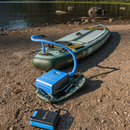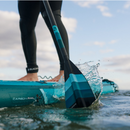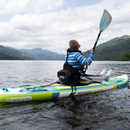Paddle Board Safety: Checklist and Practical Tips

Paddle boarding has become a popular recreational activity, attracting millions to enjoy tranquil glides on scenic waterways. However, a report by the Water Sports Foundation indicates a worrying trend: paddle sports accidents reached record highs in 2020, with fatalities accounting for over 26% of all boating deaths that year.
Despite its accessibility, research suggests 74.6% of those who died in these accidents had less than 100 hours paddle boarding. This guide will equip you with a checklist for your paddle board safety, covering essential equipment, weather forecasts, knowledge building, and preparation for various situations, so you can navigate the waters with confidence.
Paddle Board Safety: Before You Start
Ensuring a safe paddle boarding experience involves more than just the right board; it starts with understanding essential safety measures and safety equipment for paddle boards.

Whether you're a novice or a seasoned paddler, focusing on paddle board safety requirements can make the difference between a memorable outing and a risky situation.
1. Weather Check
Before embarking, reviewing the day's weather forecast is essential for paddle board safety. Reliable weather apps or websites (The Weather Channel, AccuWeather, Carrot Weather, Windy, etc.) can inform you about any impending storms or strong winds that could make paddle boarding unsafe.
2. Equipment Inspection
A thorough paddle boarding safety equipment inspection is essential for both safety and optimal performance.
- Inspect your paddle board: Check for visible damages like cracks or leaks, as these can compromise your safety.
- Leash and Personal Flotation Device (PFD): Make sure they are in good condition, as they are essential safety items.
- Check your paddle: A damaged paddle could break, leaving you stranded.
3. Safety Gear
The importance of having the right safety gear cannot be overstated - here's what you need to bring to protect yourself while having fun:
- Properly fitting PFD: This keeps you afloat in case you fall off.
- Protective clothing: Depending on the weather, wear a rash guard or wetsuit for protection.
- Whistle or signaling device: Carry one for emergencies to alert nearby watercraft or people.
- Recommended personal items: Pack sunscreen, sunglasses, water, snacks, phone, and essentials for a fun and sun-safe outing.
- Other gear items: This list includes gear like a paddle board safety strap, paddle board safety lights, navigation, storage, communication, and emergency preparedness.
Paddle Board Safety: Getting on the Water
As you gear up for a paddle boarding session, adhering to essential safety measures can be the key to an exhilarating outing rather than a risky ordeal. Here are crucial paddle board safety tips for a safe and joyous time on the water.

- Location Assessment: Choose a location that aligns with your skill level. Whether it's a calm lake, a gentle river, or coastal waters, the conditions should match your experience.
- Inform Someone: Before you head out, let a friend or family member know your plans, including your expected return time. This adds an extra layer of paddle boarding safety.
- Carry a waterproof phone: While bringing your phone lets you capture the moment on your paddle board adventure, make sure it's in a waterproof case to shield it from splashes and potential dunks.
How to Know the Wind Strength and Weather?
To have a safe and fun time paddling, it's important to check the weather and wind speed before you start.
- Check Wind Strength: Try to paddle when the wind is gentle, around 10 knots (15 km/h) or less. Stronger winds can make the water rough, making paddling harder. We suggest you should paddle against the wind first to make the return trip easier.
- Monitor Wind Direction: Look for winds heading toward the beach from the ocean. It’s best to avoid offshore winds as they may easily push you farther out from the beach and make it more difficult to return.
- Check Conditions and Forecasts: Make sure you check the most recent wind and weather forecasts before you set out. Use weather apps or consult local resources to keep informed—this simple step may help ensure a safe and enjoyable paddling experience!
Paddle Board Safety: On the Water
Once you're out on the water, maintaining a focus on paddle board safety becomes even more critical for a satisfying and incident-free paddle boarding session.

1. Proper Paddling Technique
Maintaining a balanced stance on your paddle board means keeping your feet parallel and hip-width apart while slightly bending your knees. This position helps distribute your weight evenly on the board, making it easier to navigate and reducing the likelihood of tipping over.
Using correct paddle strokes means understanding how to hold and maneuver the paddle to move forward, turn, and stop efficiently. Mastering these techniques will make your ride more enjoyable and help you stay in control, reducing the risk of accidents or injuries on the water.
2. Know Your Limits
Always paddle in conditions appropriate to your skill level. Beginners should choose calm, undisturbed seas that are not impacted by strong currents or winds. You may gradually begin experimenting with increasingly challenging environments as you gain more experience.
For added protection, remember to paddle with a partner and notify someone in land of your plans.
3. Life Leash
A paddle board safety leash is a must-have in your paddle board safety kit. Always attach the SUP leash to your ankle. It should not be tangled or dragged in the water which could lead to accidents.
4. Be Aware of Other Watercraft
Be careful and pay attention to what's around you, especially in places with lots of jet skis and boats.
Try to stay away from busy water areas where accidents are more common. Wear bright clothes so people can see you easily, and stay near the shore or in marked areas to reduce risks.
5. Learn How to Fall Properly
It is critical to understand how to fall safely while paddle boarding since it is all part of the adventure. Here are 3 easy tips for you:
- Try to fall away from your board.
- Wear a leash at all times so as not to get far away from your board.
- Before you fall, consider the water's depth to ensure a safe landing.
During your paddle boarding adventure, you may reduce the chance of injury with a little careful planning.
6. Capsizing
If you fall off the board:
- Stay calm: Panic can worsen the situation, leading to poor decision-making and increased stress levels.
- Flip the board: If your board has flipped, use your hands to flip it back over, ensuring it's stable before attempting to re-board.
- Re-board: Practice getting back onto the board safely by using the handles or sides, and always remount from the water-level side to minimize the risk of further capsizing.
7. Unforeseen Circumstances
Be aware of your surroundings, and take appropriate action in unexpected situations for your paddle board safety:
- Wildlife encounters: Know what to do if you encounter marine life, such as maintaining a safe distance and avoiding sudden movements that may provoke the animal.
- Changing weather: Be ready to head back to shore if weather conditions deteriorate, keeping an eye out for warning signs like dark clouds, choppy water, or sudden temperature drops.
What to do when you are caught in unexpected strong winds?
If you find yourself in strong winds while paddling, remember to stay calm. If you fall off, your leash will keep your board close to climb back on. If it’s hard to paddle standing, kneel on your paddle board for better control. Don’t try to get back to where you started from. Instead, aim your paddle back in the direction not directly fighting the wind. If the wind is too strong, lay on your board, tuck the paddle blade under your chest, and swim with your arms.
Paddle Board Safety: Paddle Boarding with Others
Paddle boarding with friends or family amplifies the fun but also calls for extra paddle board safety measures. This section offers guidelines to keep everyone safe and ensure a joyful time on the water.
1. Group Communication
Clear communication is vital when paddle boarding with others. It's important to maintain constant contact with fellow paddlers, especially if you're covering larger distances or navigating challenging water conditions.
Before setting out, establish a set of signals or even carry waterproof communication devices so everyone can call for help or issue warnings if necessary. This ensures that the group can respond quickly to any unexpected situations.
2. Group Safety Briefing
Prior to hitting the water, you and your group need to have a comprehensive pre-paddle discussion. Outline your intended route, highlighting any obstacles or notable features you might encounter.
Make sure that all participants understand emergency procedures, like what steps to take if someone falls off their board or if the weather takes a turn for the worse. A thoroughly prepared plan and collective understanding of it not only boosts the group's safety but also enriches the overall paddle boarding experience.
Paddle Board Safety: Additional Tips
Here are some other additional paddle board safety tips to ensure a secure adventure on the water for everyone:
1. Stay Hydrated
Bring enough water to stay hydrated, especially on hot days. Being dehydrated can make it harder to perform well and increases the chance of accidents.
2. Sun Safety
Select a sunscreen that blocks both UVA and UVB sunrays by using an SPF of 30 or even higher. Use protection like a hat or rash guard, and goggles or sunglasses with polarized lenses to protect the eyes.
3. Know the Rules
Familiarize yourself with local regulations, including permitted zones, priority rules, and any restrictions on watercraft. Understanding these standards can protect your and others' safety on the water.
4. Paddle Board Safety Course
Consider taking a safety course to learn the required techniques. Many organizations provide training courses covering navigation, emergency response, and rescue techniques.
5. Physical Fitness
Make sure you're in good shape to handle the physical demands of the activity. Strength training can assist in stabilizing your balance and the specific power required for paddling, while cycling or jogging every day can assist enhance your endurance. Yoga is also good for improving stability and flexibility.
Staying in good shape improves both your skills and confidence on the water. This makes your paddling trips more enjoyable.
Paddle Boarding Safely with iROCKER
Paddle board safety should be your top priority, whether you're a beginner or a seasoned paddler. From checking the weather and paddle board safety requirements to knowing how to handle unforeseen circumstances, being well-prepared can make a difference. Follow these guidelines to help you have a safe and memorable paddle boarding experience.

Head over to iROCKER's website now to check out our extensive range of SUP accessories and gear created to enhance your safety and elevate your excursions. Gear up for your next paddling trip now!






